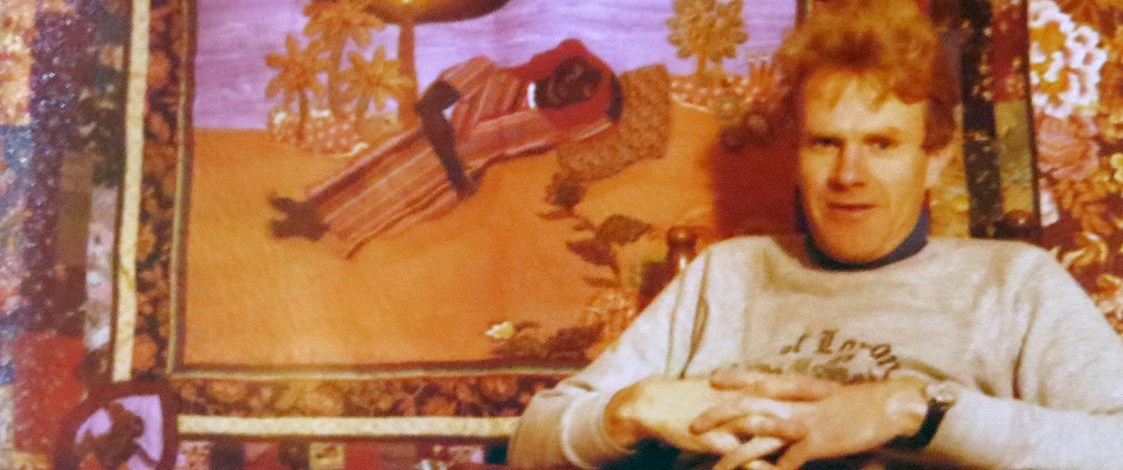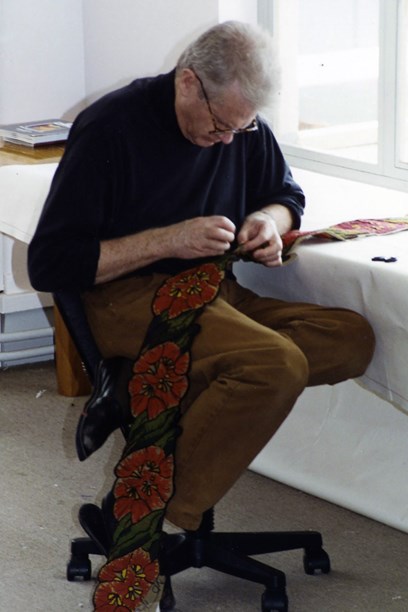Stories
Malcolm Harrison
1941-2007

Textile artist Malcolm Harrison is best remembered for his quilted and stitched artworks created throughout an extensive career. Before focusing on textile artistry however Malcolm held a small place in the New Zealand fashion industry in the 1960s, when "he was a household name for his highly regarded bridal wear, glamorous gowns, hand-stitched bespoke suits and ready-to-wear originals" (Peter Kitchin, The Dominion Post, 2007).
Born in Christchurch in 1941, Malcolm’s interest in working with cloth and thread was developed in childhood. His brother Graeme recalls that growing up, all the children in the family were taught handicraft skills and were encouraged with indoor craft activities on rainy days. This included on one occasion the creation of Malcolm’s first doll, 'Inky', who was sewn from a pair of old black stockings; likely the first iteration in one of Malcolm’s most popular series of work - 'The Family' - a collection of 35 rag doll like characters created between 1983-1987 and now owned and regularly exhibited by The Dowse Art Museum in Lower Hutt.
Malcolm Harrison's sketches. Image © Graeme Harrison.
Malcolm had wanted to attend art school, however his strict traditional family did not approve and he embarked on a three-year apprenticeship as a window-dresser at The DIC department store in Christchurch. This work included dressing the front windows of the store and it was reported that Malcolm so convincingly draped fabrics on to the mannequins that customers were requesting the 'garments' to purchase (Ann Packer, Art News, 2008). This experience, coupled with night classes in pattern-making at Christchurch Technical College, led to the creation of a series of gowns which he entered in the Gown of the Year competition.
Malcolm was part of a contingent of new young male designers participating in awards as a platform to break into the fashion scene (Claire Regnault, The New Zealand Gown of the Year, 2002). Malcolm entered the Professional Mannequins Association Golden Shears Awards and the New Zealand Gown of the Year. His first entry in 1961 in the Gown of the Year and the first ball gown he had ever made was entitled 'Bronze Goddess'. Inspired by the film Gone with the Wind, it was placed fourth, the three winners being fellow emerging male designers Robert Ryan, Kevin Berkahn and Nigel Rodda (Hawke’s Bay Today, 30 April 2003.
The following year Malcolm’s entry 'Schéhérzade' gained second place. The gown was inspired by an entry from the previous year 'Fleur d’Or' by Pour Vous and was based on a picture of the set for the ballet Schéhérzade which he had seen when he was 13. It was a soft green satin sheath style dress with a twin train which could be draped around the shoulders as a stole. It won favour with the audience and was many years later again chosen as the public favourite when displayed in the 2002-03 Gown of the Year exhibition at the Hawke’s Bay Museum. The train featured striking and elaborate Jacobean style embroidery and beading which Malcolm did himself, a prelude to the art practice he moved onto in the following decades.
His competition gowns brought him to the attention of Auckland fashion designer Colin Cole who invited him to come and work for in his salon in the 1960s. Malcolm worked under Colin Cole for a number of years before he left New Zealand and travelled on his OE to London and Europe where he gained much of the inspiration for later textile art from the sights and scenes he experienced. Upon his return home, just under two years later, he opened his own fashion boutique on the North Shore, Jasper Johnson’s Jamboree which was registered in 1970. Although it is not known where Malcolm got this unique name for his shop, we can muse that it could have been named after the 1914 song 'Down at Jasper Johnson’s Jamboree' by Verna Wilkens and Andrew K Allison.
Malcolm’s brother Graeme recalls the store fondly: "The boutique was situated on Lake Road opposite Byron Ave in Takapuna, it was a little shop maybe 6 metres wide by 20 metres, with a wide footpath veranda from which the JJJ sign was hung on two chains at the entrance. It had a yellow background, dark and light green Algerian letters with orange scrolls surrounding the border, way out and very modern for the time. The shop interior was painted dark cream, as you entered on the left there was a seat, with a few dresses hung on a stainless frame, further down on the right were two changing rooms with curtains, a divider, then on the left Malcolm’s workbench with many bolts of materials stored underneath. As 90% of his work was custom-made he never employed help, so long hours at the workbench were had to keep up."
As the decade progressed Malcolm moved his focus to textile art, particularly the areas of quilting and needlework. Whilst he had been dabbling with textiles as a hobby since childhood, it was not until this time that he seriously moved into the field with his first art quilt show with Denis Cohn gallery in Auckland in 1979. He was led into the quilting field through the dress fabric scraps which were plentiful from his boutique and later from his sister-in-law’s connection to a wholesale dress fabric merchant. He started playing around with these, experimenting with the quilt making form and quickly fell in love with the medium.
A renewed excitement for his materials combined with a growing boredom with the fashion industry and frustration at restrictions placed on his designs by clientele inspired him to leave fashion behind. He was quoted as calling the industry a "seething pit of fashion snakes" and decided to instead enter what was likely an even more challenging world, as a male art quilter and embroiderer. Despite criticism from some needleworkers who said that "he didn't use enough stitches" and from the mainstream art world which saw his work as craft rather than art Malcolm went on to be vindicated.

Malcolm Harrison joining rata border embroidery. Image © Graeme Harrison.
In 2004 he became the first recipient of the bi-annual Creative New Zealand Craft/Object Fellowship. It was the first accolade of its kind in New Zealand to recognise the creative field of craft and object making. The award was significant in the recognition it gave to Malcolm’s career as a textile artist. A career which had included the weighty commission for the New Zealand Parliament Buildings in Wellington in the mid-1990s of These are Matters of Pride and Whanaungatanga.
Malcolm’s work is held in many major public collections across New Zealand and internationally and include not only his well-known artwork but also personal garments he wore and collected, pieces he had gifted to friends, miscellaneous historically significant fabric and other textile ephemera. While there are few garments from his time working as a fashion designer there are garments he created for himself in the years after he left the fashion industry including some quilted waistcoats and an elaborately embroidered denim jacket. His gown 'Schéhérzade' is held within the collection of MTG Hawkes Bay.
Malcolm died in 2007 aged 66 following a fall at his Waiheke Island home, he had been undergoing treatment for cancer. Living on the Island since the late 1990s, he was working actively as an artist at the time and was planning the mini-retrospective exhibition 50 Year Journey Through a Flower Market with his long time Wellington dealer Janne Land. That exhibition was realised in 2008 and in September 2017 the Waiheke Community Art Gallery hosted the first showing of a nationwide travelling exhibition, Malcolm Harrison: A Celebration.
Text by Cerys Dallaway Davidson. Banner image © Graeme Harrison.
Last published December 2017.